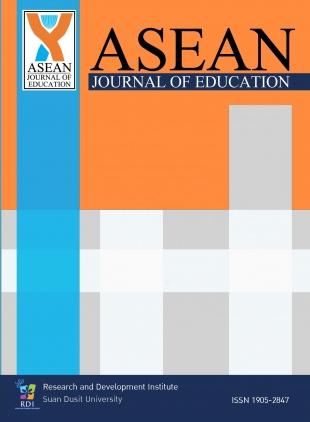University Faculty Perceptions of Their Instructional Strategy
Keywords:
Faculty m ember, Instructional strategy, Higher education, VietnamAbstract
This study explored the faculty members’ perception of their instructional strategy at the University of Social Sciences and Humanities – Vietnam National Universi t y of Ho Chi Minh City (USSH-VNUHCM) and the relationship that teaching resources, organizational culture and administrative support factors affect faculty instructional strategy were examined. A survey questionnaire measuring four factors of instructional strategy was distributed to 124 faculty members working full-time at the USSH-VNUHCM. The results indicate that most faculty members measured strongly towards their instructional strategy. In addition, the results also indicate that the different regression models had different explanation for faculty instruct i onal strategy across different factors. Generally, factors of teaching resources, organizational culture and administrative support yielded significantly differen c e that affect faculty members’ instructional strategy. The study’s implications for university management are discussed.
References
Albeta Learning (2002). Instructional Strategies. In Health and Life Skills Guide to Implementation (K–9). Retrieved August 20, 2019, from https://education.alberta.ca/media/482311/is.pdf
Akdeniz, C. (2016). Instructional process and concepts in theory and practice: Improving the teaching process. Singapore: Springer.
Baker, R. M., & Dwyer, F. (2005). Effects of instructional strategies and individual differences: A meta-analytic assessment. International Journal of Instructional Media, 32(1), 69–84.
Bandura, A. (1997). Self-efficacy: The exercise of control. New York: W.H. Freeman.
Campbell, T. I. D., & Slaughter, S. (1999). Faculty and administrators' attitudes toward potential conflicts of interest, commitment, and equity in university-industry relationships. The Journal of Higher Education, 70(3), 309-352.
Chang, T. S., Lin, H. H., & Song, M. M. (2011). University faculty members’ perceptions of their teaching efficacy. Innovations in Education and Teaching International, 48(1), 49-60.
Chang, T. S., McKeachie, W., & Lin, Y. G. (2010). Faculty perceptions of teaching support and teaching efficacy in Taiwan. Higher Education, 59(2), 207–220.
Chang, Z., & Nadine, E. (2014). Organizational culture and instructional innovations in higher education: Perceptions and reactions of teachers and students. Educational Management Administration & Leadership, 42(1), 136–158.
Clarck, L. H., & Starr, I. (1968). Secondary school teaching method (3rd ed.). New York: Collier-McMillan Ltd.
Dillman, D. A. (2000). Mail and internet surveys: The tailored design method. New York: John Wiley and Son.
Gonyea, R. M. (2005). Self-reported data in institutional research: Review and recommendations. New directions for institutional research, 127, 73-89.
Hair, J. F., Tatham, R. L., Anderson, R. E., & Black, W. C. (2009). Multivariate data analysis (6th ed.). Upper Saddle River, NJ: Prentice Hall.
Hofman, R. H., Hofman W. A., & Guldemond, H. (2002). School governance, culture, and student achievement. International Journal of Leadership in Education, 5(3), 249–272.
Lim, D. H. (2002). Perceived differences between classroom and distance education: Seeking instructional strategies for learning application. International Journal of Educational Technology, 3(1), 20–32.
Malaney, G. D. (2002). You still need high response rates with web-based surveys. Student Affairs On-Line, 3(1).
Marcoulides, G. A., Heck, R. H., & Papanastasiou, C. (2005). Student perceptions of school culture and achievement: Testing the invariance of a model. International Journal of Educational Management, 19(2), 140-152.
Marzano, R. J. (2003). What works in schools: Translating research into action? Alexandria, Virginia: ASCD.
Meyers, C., & Jones, T. B. (1993). Promoting active learning: Strategies for the college classroom. San Francisco: Jossey-Bass.
Moore, K. D. (2000). Classroom teaching skills (5th ed.). New York: McGraw Hill.
Nunnally, J. C., & Bernstein, I. H. (1994). Psychometric theory (2nd ed.). New York: McGraw-Hill.
Paneque, O. M., & Barbetta, P. M. (2006). A study of teacher efficacy of special education teachers of English language learners with disabilities. Bilingual Research Journal: The Journal of the National Association for Bilingual Education, 30(1), 171-193.
Williams, L. (2004). The relation between personality types and cooperative learning instruction in mathematics for a population of sixth grade students. (Doctoral dissertation, Sant Louis University). Proquest.
Downloads
Published
How to Cite
Issue
Section
License

This work is licensed under a Creative Commons Attribution-NonCommercial-NoDerivatives 4.0 International License.
1 All articles will undergo a formal peer-review. A panel of experts from within or without the university will examine the article; approval from a minimum of two experts is required for publication. Revisions posed by the experts must be completed by the research prior to publication.
2 Once published in the ASEAN Journal of Education, the article becomes intellectual property of Suan Dusit University. Duplication, in full or part, requires permission from Suan Dusit University.
3 Excluding errors incurred during printing, author(s) are responsible for the content of their articles.






